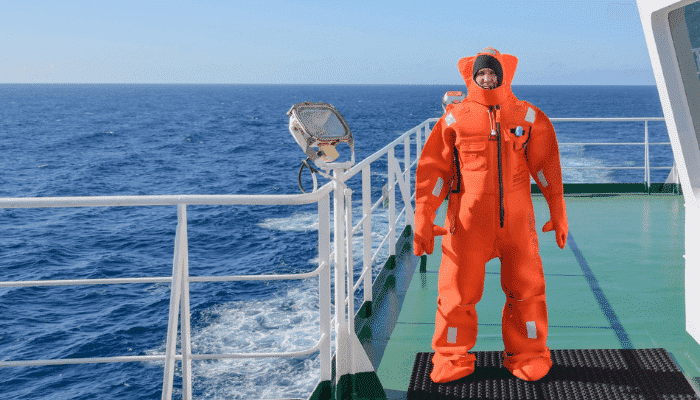Blog Post
Different Immersion Suit Types & Their Benefits
Posted By: Harsh Bamnolia
Posted On : 20-Feb-2025

Different Immersion Suit Types & Their Benefits
Understanding Different Immersion Suit Types & Their Benefits
The immersion suit types play a crucial role in maritime safety, offering life-saving protection for crew members and passengers in emergency situations.
These suits are specifically designed to provide insulation, buoyancy, and water resistance, ensuring survival in extreme weather conditions.
Maritime emergencies such as shipwrecks, capsizing, or abandoning a vessel due to fire or collision can expose individuals to harsh sea environments.
Cold water shock and hypothermia are among the leading causes of fatalities in maritime accidents, making immersion suits an indispensable part of safety gear.
The immersion suit types vary depending on their intended use, material, and regulatory requirements. In this comprehensive guide, we will explore the different immersion suit types and their benefits to help you understand their significance in maritime safety.
Different Immersion Suit Types and Their Uses
Maritime safety regulations require vessels to carry immersion suits as part of their emergency equipment. However, different types of immersion suits cater to various safety needs.
Some are designed for extreme cold conditions, while others are meant for moderate temperatures or specialized rescue missions.
Below are the most common types of immersion suits and their key uses:
1. Insulated Immersion Suit
Made from high-quality neoprene or similar material.
Designed to keep body temperature stable for prolonged exposure to cold water.
Offers excellent buoyancy and insulation properties.
Suitable for harsh environments with freezing temperatures.
Often used on cargo ships, tankers, and fishing vessels operating in Arctic or Antarctic waters.
Reduces the risk of hypothermia by maintaining core body temperature.
2. Non-Insulated Immersion Suit
Lightweight and flexible, allowing for easier movement.
Ideal for moderate water temperatures.
Requires additional thermal wear to provide sufficient warmth.
Commonly used in coastal waters where extreme cold exposure is unlikely.
Easier to store and don compared to insulated suits.
3. Hybrid Immersion Suit
Combines elements of both insulated and non-insulated suits.
Provides moderate insulation while allowing flexibility and ease of movement.
Suitable for mixed climate conditions.
Can be worn for extended periods without causing discomfort.
Used by offshore oil rig workers, search and rescue teams, and emergency responders.
4. Constant-Wear Immersion Suit
Designed for extended wear in harsh working environments.
Commonly used by offshore workers and ship personnel who may need immediate protection.
Offers high comfort levels without compromising safety.
Typically made from lightweight, breathable materials.
Often features reinforced knees, elbows, and soles for durability.
5. Aviation and Helicopter Crew Immersion Suit
Specifically designed for pilots and crew members working over open waters.
Features an anti-flame outer layer for additional protection.
Lightweight, allowing easy movement in confined spaces.
Some models include additional harnesses for helicopter rescue operations.
Essential for personnel flying over remote sea areas or Arctic regions.
6. Survival Suit with Built-in Life Jacket
Includes an integrated life jacket for enhanced flotation and safety.
Ideal for emergency situations where immediate buoyancy is required.
Designed to improve visibility in search and rescue operations.
Ensures compliance with SOLAS (Safety of Life at Sea) regulations.
Used on passenger ships, commercial vessels, and offshore platforms.
7. Child and Infant Immersion Suits
Specially designed for younger passengers and infants.
Comes with smaller sizes and additional safety features.
Helps keep children buoyant and warm in case of an emergency.
Often used on cruise ships and ferries.
Benefits of Different Immersion Suit Types
Each immersion suit type provides unique benefits depending on its design and purpose. Below are some key advantages that make immersion suits indispensable for maritime safety:
1. Protection from Hypothermia
Hypothermia occurs when the body loses heat faster than it can produce, leading to dangerous drops in core temperature.
Immersion suits act as thermal barriers, preventing excessive heat loss and increasing survival time in cold waters.
2. Enhanced Buoyancy
Most immersion suits feature built-in buoyancy aids, reducing the risk of drowning.
Some include inflatable chambers or integrated life jackets for additional floatation.
3. Regulatory Compliance
SOLAS and IMO-approved immersion suits ensure vessels meet international safety standards.
Ships must carry approved immersion suits for every crew member on board.
4. Improved Visibility
High-visibility colors (such as bright orange and red) make it easier for rescue teams to locate survivors.
Reflective tape and built-in whistles enhance visibility and attract attention in low-light conditions.
5. Durability and Comfort
Advanced neoprene and nylon materials ensure longevity while maintaining flexibility.
Some designs feature breathable fabric and reinforced seams to enhance user comfort.
6. Quick and Easy Donning
Emergency suits are designed for rapid deployment in case of ship evacuations.
Some immersion suits include self-donning zippers and adjustable cuffs for quick dressing.
7. Protection from Flames and Chemicals
Some specialized suits offer fire resistance to protect against burns and chemical exposure.
Used in oil rigs, chemical tankers, and military applications.
Choosing the Right Immersion Suit
Selecting the right immersion suit type depends on various factors, including:
Temperature of the water where the ship operates.
Type of vessel (cargo ship, oil rig, ferry, fishing boat, helicopter, etc.).
Required regulatory compliance (SOLAS, IMO, etc.).
User comfort and intended use (constant wear vs. emergency use).
Additional safety features such as built-in harnesses, visibility markers, and reinforced soles.
Shipowners and maritime operators should consult safety experts to determine the most suitable immersion suits for their fleet.
Conclusion
Understanding immersion suit types is vital for ensuring the safety of maritime professionals and passengers.
Whether it is an insulated suit for icy waters or a constant-wear suit for daily protection, having the right immersion suit can be a lifesaver in emergency situations.
At Marinetech Safety & Shipping Corporation, we offer a wide range of SOLAS-approved immersion suits designed for maximum protection and comfort.
To explore our collection of high-quality life-saving equipment, visit: https://marinetechss.com/supplies/life-saving-equipments.